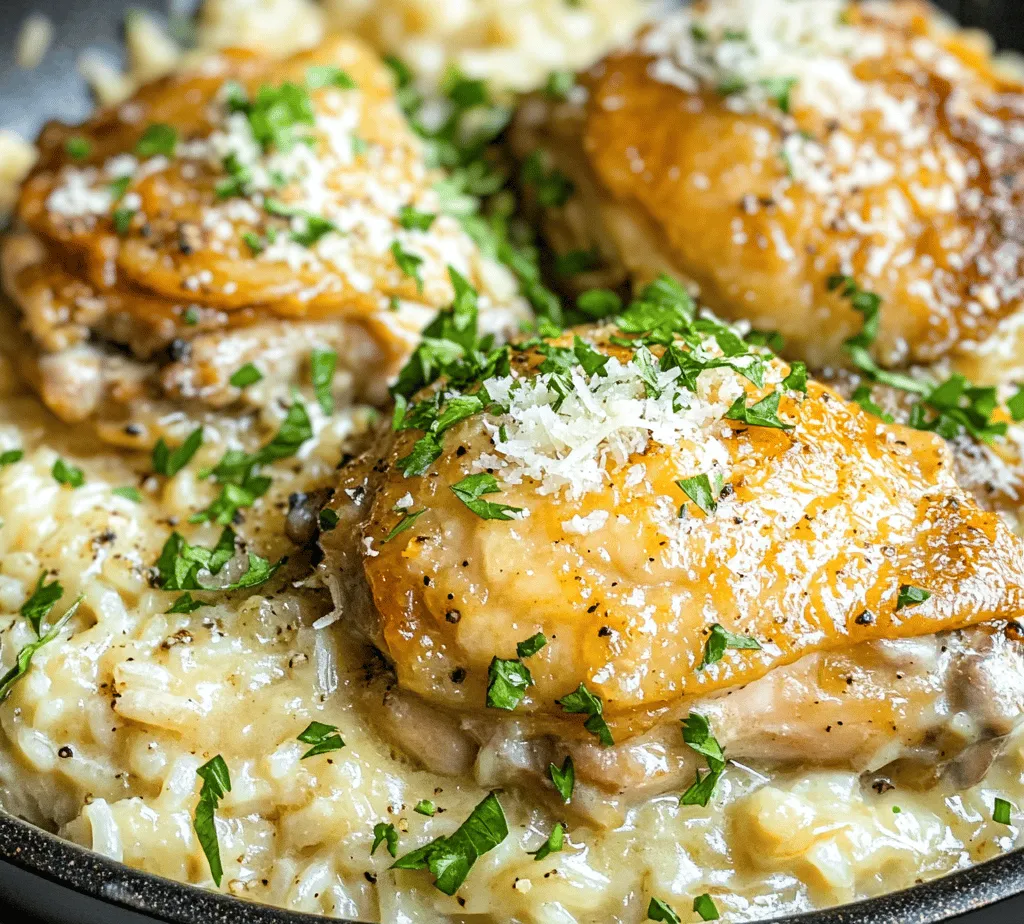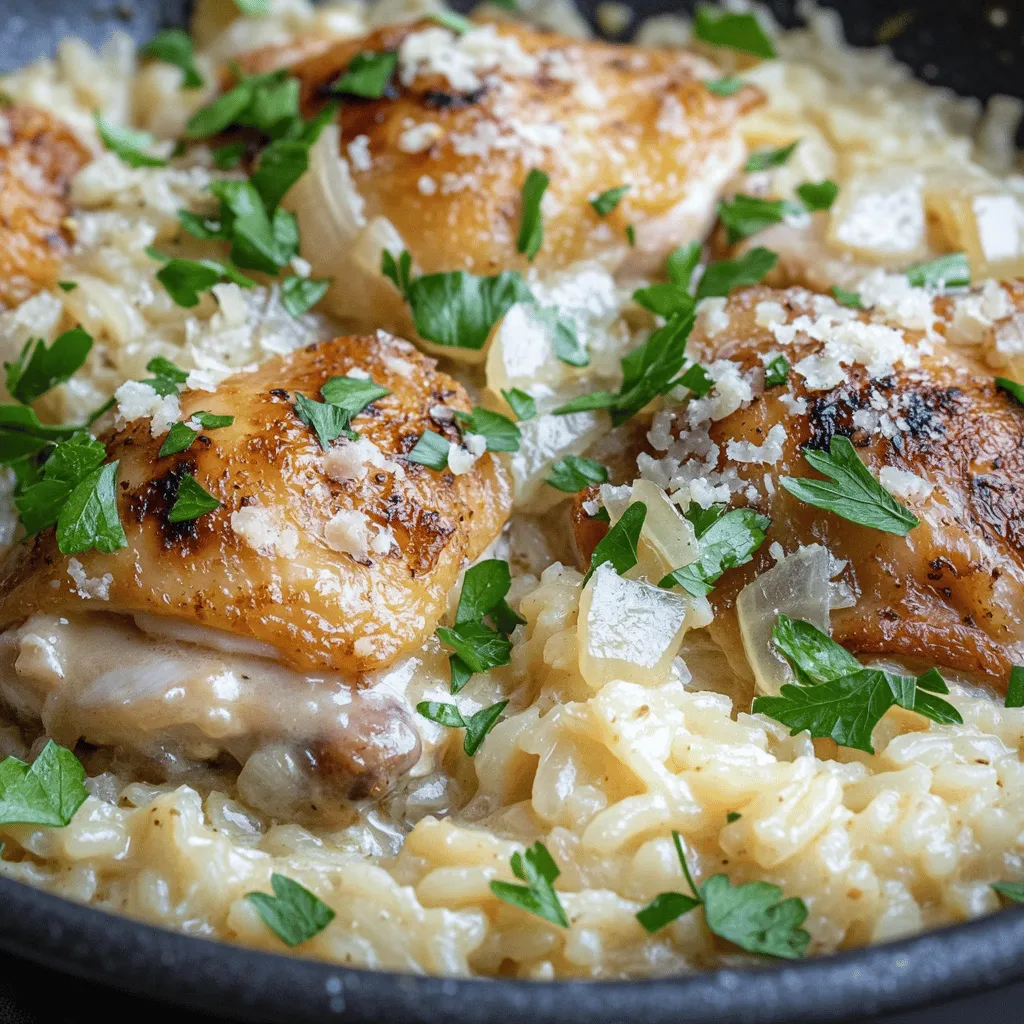Introduction
In today’s fast-paced world, the appeal of one-pan meals has never been greater. Busy schedules and the desire for simplicity in the kitchen drive home cooks to seek recipes that are not only easy to prepare but also deliver on flavor and comfort. One such dish that perfectly embodies these qualities is Creamy Parmesan Chicken & Rice. This dish combines the heartiness of chicken with the creaminess of a rich sauce and the satisfying texture of tender rice, all cooked together in a single pan. The result is a comforting meal that pleases the palate while minimizing cleanup—making it an ideal choice for weeknight dinners or gatherings.
What sets this recipe apart is its convenience and versatility. With just a few quality ingredients, you can create a flavorful and filling meal that everyone at the table will love. The creamy sauce, infused with the nutty flavor of Parmesan cheese, envelops succulent chicken thighs and perfectly cooked Arborio rice, creating a harmonious blend of flavors and textures. Whether you are a seasoned chef or a beginner in the kitchen, this one-pan dish is sure to impress.
Understanding the Ingredients
To create a truly delectable Creamy Parmesan Chicken & Rice, it is essential to use quality ingredients. Each component plays a significant role in the overall flavor and texture of the dish, so let’s break down the key ingredients that make this recipe shine.
Chicken Thighs
For this recipe, boneless and skinless chicken thighs are the preferred choice. Unlike chicken breasts, which can easily dry out during cooking, chicken thighs are naturally more flavorful and juicy. They contain a bit more fat, which helps keep the meat tender and moist, making them perfect for a creamy dish. Additionally, thighs are forgiving in terms of cooking time; they can withstand a little extra heat without becoming tough, ensuring that you achieve the perfect texture.
Arborio Rice
Arborio rice is a short-grain rice that is known for its high starch content, which is crucial for achieving a creamy texture. Traditionally used in risotto, Arborio rice absorbs flavors beautifully while releasing starch during cooking, resulting in a luscious, velvety consistency. When combined with the heavy cream and Parmesan cheese in this recipe, Arborio rice creates a delightful base that balances the richness of the dish. Its ability to hold up during the cooking process without becoming mushy makes it an ideal choice for this one-pan meal.
Heavy Cream
Heavy cream is the secret ingredient that elevates this dish to creamy perfection. Its high fat content provides a luxurious mouthfeel and richness that transforms the chicken and rice into a comforting meal. When heated, heavy cream thickens beautifully and creates a velvety sauce that clings to the chicken and rice, ensuring each bite is packed with flavor. For a lighter version, you can substitute half-and-half, but keep in mind that the dish may not be as rich and creamy.
Parmesan Cheese
Parmesan cheese is another key player in this recipe, contributing both flavor and creaminess. The nutty, salty notes of freshly grated Parmesan enhance the overall taste of the dish and deepen the umami profile. As the cheese melts into the sauce, it adds an irresistible creaminess that pairs perfectly with the chicken and rice. For the best results, opt for freshly grated Parmesan rather than pre-shredded varieties, as the latter often contain anti-caking agents that can affect the texture of the sauce.
Fresh Herbs
To finish off this dish, fresh herbs are not just a garnish; they play a vital role in enhancing the overall flavor profile. Fresh parsley or basil can add a burst of freshness and color that balances the richness of the creamy sauce. When sprinkled on top just before serving, these herbs provide a contrast that elevates the dish and makes it visually appealing. Additionally, incorporating herbs into the cooking process, such as adding them during the sautéing of vegetables, can infuse the dish with aromatic notes that enhance its complexity.
Preparing the Chicken
Now that we’ve covered the essential ingredients, it’s time to dive into the preparation of the chicken. The way you season and cook the chicken thighs can significantly impact the overall flavor of the dish.
Seasoning the Chicken Thighs
Start by seasoning the chicken thighs generously with salt and pepper. This step is crucial, as it enhances the meat’s natural flavor. You can also incorporate additional spices, such as garlic powder, onion powder, or smoked paprika, to add depth to the seasoning. Allow the seasoned chicken to rest for a few minutes before cooking—this helps the flavors to penetrate the meat.
Importance of Browning Chicken
Browning the chicken thighs is a vital step in developing flavor and achieving a desirable texture. As the chicken cooks, the Maillard reaction occurs, creating a beautiful golden-brown crust that adds complexity to the dish. To achieve the best browning without overcooking the chicken, use a large skillet or sauté pan over medium-high heat and add a drizzle of olive oil or a pat of butter. Ensure that the pan is hot before adding the chicken, as this helps to create that coveted sear.
Tips for Achieving Perfect Browning
To achieve perfect browning, avoid overcrowding the pan. Cook the chicken in batches if necessary to ensure even cooking and browning. Let the chicken sear undisturbed for several minutes before flipping; this allows the crust to form. Once the chicken is browned on both sides, it can be removed from the pan and set aside while you prepare the rest of the dish. This step not only locks in flavor but also allows you to utilize the fond—those delicious browned bits stuck to the bottom of the pan—when sautéing the vegetables.
Sautéing the Vegetables
With the chicken beautifully browned and resting, it’s time to turn our attention to the vegetables. Sautéing onions and garlic is the next step in building the flavor base for our creamy dish.
Steps for Sautéing Onions and Garlic
Begin by adding a bit more olive oil or butter to the same pan you used for the chicken. This will help to deglaze the pan and incorporate the fond into your sauté. Once the oil is hot, add diced onions and sauté them until they become translucent and fragrant. This usually takes about 3 to 5 minutes. The onions will soften and caramelize slightly, adding sweetness to the dish.
Next, add minced garlic to the pan. Garlic cooks quickly, so be sure to stir it into the onions and cook for an additional 30 seconds to one minute, until aromatic. The combination of sautéed onions and garlic lays the foundation for a rich flavor profile, enhancing the overall taste of the Creamy Parmesan Chicken & Rice.
The Role of Aromatics
Aromatics, such as onions and garlic, are essential in cooking as they create a flavor base that elevates any dish. They not only provide an aromatic quality but also contribute sweetness and depth. By taking the time to properly sauté these ingredients, you ensure that their flavors fully develop and infuse the dish, resulting in a more satisfying and layered taste experience.
With the chicken seasoned and browned, and the vegetables sautéed to perfection, you are well on your way to creating a delicious Creamy Parmesan Chicken & Rice that will impress your family and friends alike. Stay tuned for the next stages of this recipe, where we will combine all these elements into a cohesive and flavorful one-pan meal.

Significance of Using the Same Pan for Cooking the Chicken and Vegetables
Using the same pan for cooking both the chicken and vegetables is an essential technique that enhances the overall flavor and texture of your One-Pan Creamy Parmesan Chicken & Rice. This method not only reduces the number of dishes you need to clean up after cooking but also allows the ingredients to share their flavors throughout the cooking process. When you sear the chicken first, it leaves behind flavorful bits and juices in the pan, which are then infused into the vegetables and rice. This creates a harmonious taste profile that is both rich and satisfying.
Additionally, cooking in one pan promotes a more efficient cooking process. The residual heat and flavors meld together, creating a depth of flavor that you simply cannot achieve by cooking ingredients separately. The chicken becomes tender and juicy, while the vegetables absorb the savory essence left in the pan, resulting in a dish that is not only delicious but also easy to prepare.
Toasting the Rice
Toasting the rice is a crucial step in the preparation of this dish, particularly when using Arborio rice, which is known for its creamy texture. The toasting process enhances the nutty flavor of the rice and helps to create a better overall texture in the final dish. When rice is toasted, it undergoes a process called the Maillard reaction, which develops its flavor and gives it a subtle golden hue.
To properly toast Arborio rice, start by adding it to the pan after the chicken has been removed. Allow the rice to cook in the residual oil and juices on medium heat for about 2-3 minutes. Stir frequently to prevent sticking and ensure even toasting. You want to achieve a lightly toasted appearance, which will signal that the rice is ready for the next step. Maintaining the right heat is crucial during this process; too high can burn the rice, while too low will not produce the desired flavor enhancement.
Combining Ingredients for Cooking
Once the rice is toasted to perfection, it’s time to combine it with the broth and cream mixture. This step is vital, as the liquid not only cooks the rice but also infuses it with flavor. Use a good-quality chicken broth for a rich base; this will enhance the dish’s overall taste. Pour the broth into the pan, followed by the heavy cream, and stir to combine.
Achieving the right simmering temperature is key to ensuring the rice cooks evenly and absorbs the flavors. Bring the mixture to a gentle simmer, which is characterized by small bubbles forming on the surface without a full boil. Once simmering, carefully nestle the chicken pieces back into the rice, ensuring that they are partially submerged. This technique allows the chicken to cook through while also imparting its flavors into the rice, creating a cohesive dish.
Finishing Touches: Adding Cheese and Seasoning
Timing is everything when it comes to adding Parmesan cheese to your One-Pan Creamy Parmesan Chicken & Rice. For the best texture and creaminess, add the cheese towards the end of the cooking process, just after the rice has absorbed most of the liquid. This allows the cheese to melt seamlessly into the dish, creating a velvety sauce that coats the chicken and rice.
Adjusting the seasoning is another important finishing touch. Taste the dish before serving and adjust as necessary. A balance between salt, pepper, and Italian seasoning is essential to elevate the flavors without overpowering the dish. Italian seasoning adds a wonderful depth, enhancing the overall taste without needing additional ingredients.
For those looking to get creative, consider experimenting with different cheeses or spices. For instance, substituting half of the Parmesan with mozzarella can add a delightful stretchiness to the dish. Alternatively, a sprinkle of smoked paprika can add a unique depth of flavor that complements the creaminess beautifully.
Serving Suggestions
Presentation is key when it comes to serving your One-Pan Creamy Parmesan Chicken & Rice. A simple yet elegant way to present the dish is to serve it directly from the pan, garnished with freshly chopped parsley. The vibrant green of the parsley not only adds a pop of color but also enhances the flavor profile of the meal.
Pairing options are also an important consideration. A crisp side salad with a light vinaigrette can provide a refreshing contrast to the richness of the chicken and rice. Alternatively, serve with roasted vegetables or a side of garlic bread for a heartier meal. These accompaniments complement the creamy dish perfectly while adding balance to the overall dining experience.
Conclusion
In summary, the One-Pan Creamy Parmesan Chicken & Rice is a delightful dish that combines simplicity with rich flavors, making it an ideal choice for busy weeknights or a comforting family meal. The technique of toasting the rice, along with the careful layering of flavors and textures, elevates this dish to a new level of deliciousness.
We encourage you to try this recipe for yourself and experience the joy of one-pan cooking. Not only does it save time and reduce cleanup, but it also allows for a more flavorful meal that can easily become a staple in your cooking repertoire. Embrace the ease and satisfaction of creating a comforting dish that brings everyone to the table with one-pan perfection.



